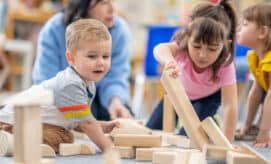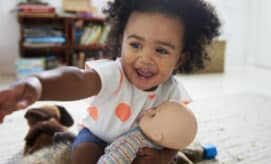Did you know that our brains grow faster between the ages of 0 and 3 than at any later point in our lives? During the first three years of life, the brain grows rapidly in size and complexity. Each time an infant’s brain takes in information and registers something new about the world, a new neural connection is formed. In fact, an infant’s brain forms more than one million new neural connections every second!
Brain-building and Early Relationships with Caregivers
These early neural connections are strengthened when young children and their caregivers interact with one another through eye contact, facial expressions, and vocal sounds. These early adult-child relationships set into motion the neural connections that become the foundation for healthy cognitive development and for ongoing learning and relationship-building.
First Things First, an early education and health organization in Arizona, describes the early and lifelong impact of caregivers: “Children develop brain connections through their everyday experiences. They’re built through positive interactions with their parents and caregivers and by using their senses to interact with the world. A young child’s daily experiences determine which brain connections develop and which will last for a lifetime. The amount and quality of care, stimulation and interaction they receive in their early years makes all the difference.”
Our work with young children has a profound and lasting impact – this is why it is so important!
Noticing Early Cognitive Milestones
During their first three years of life, children develop a variety of cognitive skills that allow them to move, think, and communicate more effectively. The list below includes milestones in cognitive skill-building that you might observe between birth and three years old.
First Year
-
Reflexive communication. Before young children start speaking, they communicate with sounds, facial expressions, and movements. Infants, for example, might coo or laugh when they are happy, reach for items that interest them, or frown when they try food they don’t like.
-
Joint attention. Joint attention refers to sharing an activity or something of interest with another person at the same time. The organization Before Their First Words describes joint attention during the first year of life, explaining that it “usually occurs in playful situations with caregivers, for example, reading a book, building a tower, finding hidden objects together or pretending to eat and drink.”
One – Two Years Old
-
Matching and categorizing. Around this age, children become aware of the ways in which objects can be the same or different from one another. They might start to match together things that are the same and put them into categories. This is an important skill that will help them in later mathematics!
-
Theory of mind. As early as 18 months, children begin to develop an awareness that other people have their own thoughts, feelings, and ideas. You might notice children demonstrating early signs of this skill when they engage in pretend play, as they act out what another person might do or say.
Two – Three Years Old
-
Symbolic thinking. Symbolic thinking refers to the ability to recognize that one item can stand in for another. It is a foundational skill for pretend play, as when a child offers a pretend bottle to a baby doll.
-
Logical thinking skills. Around this age, children begin to understand the ways that things are logically connected. When logical thinking skills are developing, you might notice a lot of “why” questions from children seeking to get a better understanding of how different things work and interact with each other.
Supporting Brain Development: Tips for Caregivers
The early learning organization, Vroom, encourages caregivers to support brain development by engaging in everyday interactions with young children. Below are some simple suggestions from Vroom that will help you support the early learners in your care.
-
Look! Children use their eyes to learn as they notice different things in the world around them. Try to observe what young children are looking at, and talk with them about it. Or connect eye-to-eye, then smile, chat, and make funny faces!
-
Chat! Children’s brains light up when caregivers talk, sing, or make sounds back and forth with them. Chat about your day, food, and what’s around you, or string sounds together for a fun conversation!
-
Follow! Young children learn best when you follow their lead. Tune into the child’s words, sounds, movements, and ideas! Then respond with your own words and actions.
-
Stretch! Children’s brains grow strong when you help them stretch their learning further. Keep a moment going by asking children questions that start with what, when, where, how, or why!
If you’d like to share these tips, Vroom offers them on its website as free printable flyers in English, Spanish, Chinese, and several other languages.






